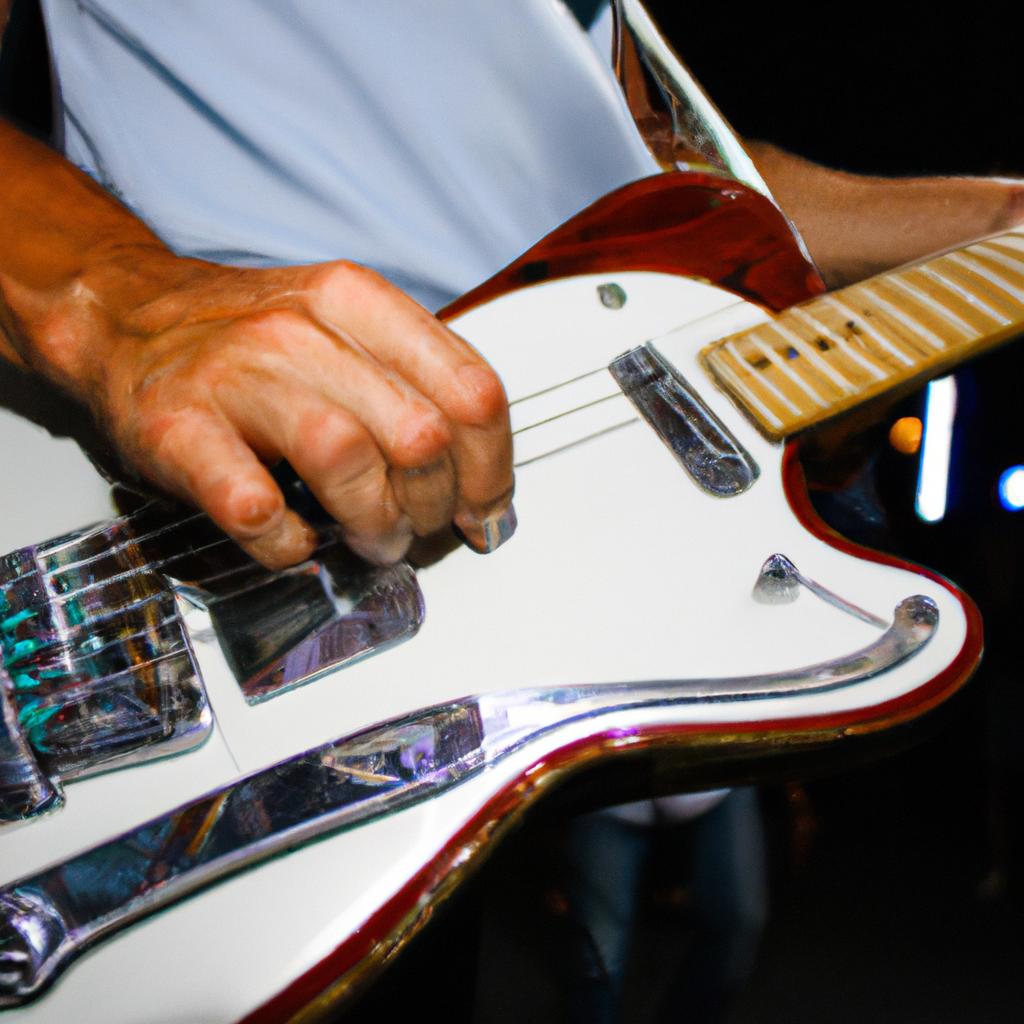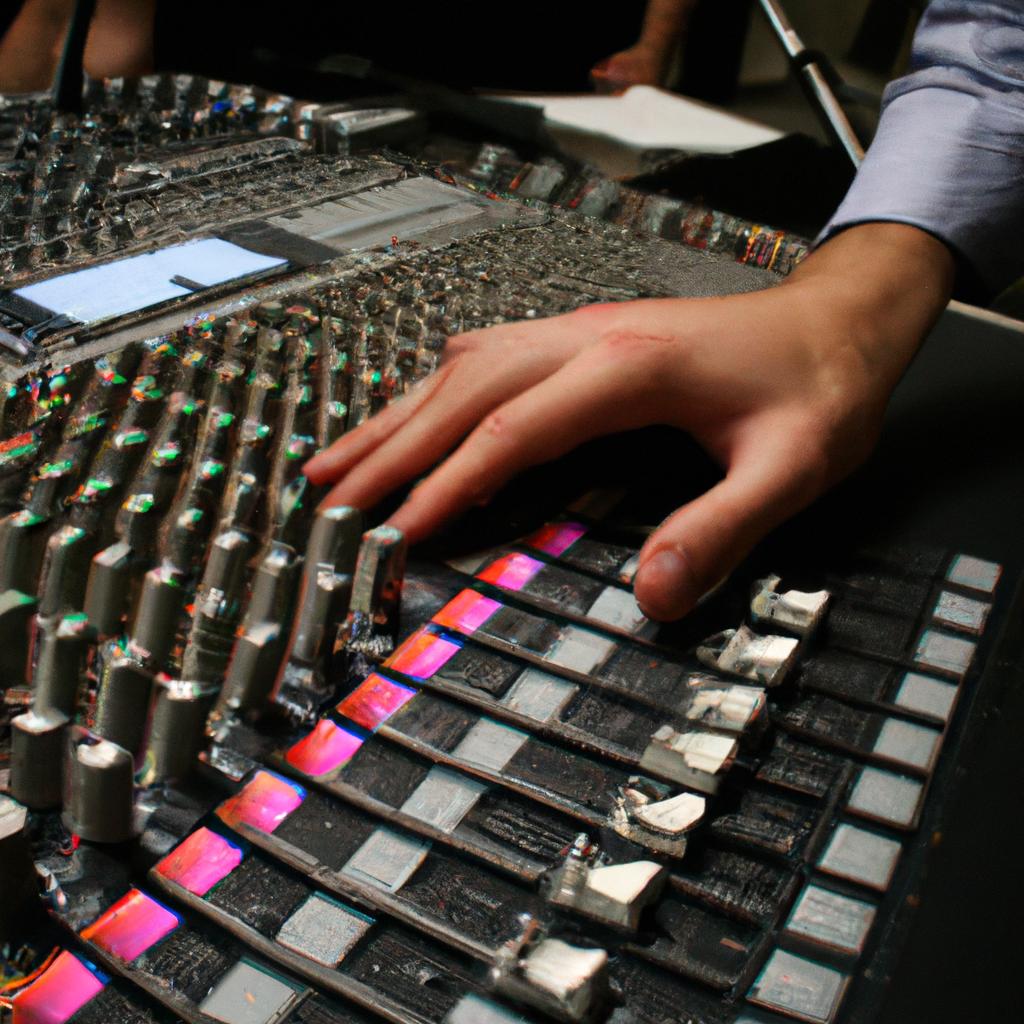Live performances are a crucial aspect of an artist’s career, providing them with a platform to connect with their audience and showcase their musical prowess. One key element that contributes to the success of a live performance is the careful selection and arrangement of songs in a setlist. This article aims to provide a comprehensive guide on setlist creation for live performances, drawing insights from the expertise of renowned musician Jose Carlos Matos. By analyzing case studies and applying theoretical principles, this article will offer valuable strategies and considerations for musicians seeking to create impactful and memorable setlists.
Imagine attending a concert where the artist effortlessly transitions from one song to another, seamlessly weaving together familiar hits while introducing new material without losing the crowd’s energy. This scenario exemplifies the artistry involved in crafting an effective setlist. A well-designed setlist can enhance the overall experience for both performers and audiences alike by maintaining momentum, evoking emotions, and showcasing versatility. However, constructing such a seamless sequence requires thoughtful consideration of various factors including song selection, tempo dynamics, thematic cohesion, and audience engagement. Through exploring these elements within real-life examples as well as theoretical frameworks proposed by Jose Carlos Matos Music, this article seeks to empower musicians with practical guidance on navigating the intricacies of setlist creation and maximizing the impact of their live performances.
One crucial aspect of setlist creation is song selection. It is important to consider the familiarity and popularity of songs among the audience. Including well-known hits can create an immediate connection with the crowd and generate excitement. However, it is also essential to balance these crowd-pleasers with lesser-known tracks or new material to keep the performance fresh and showcase artistic growth.
Another consideration in creating a successful setlist is tempo dynamics. Jose Carlos Matos Music suggests incorporating a mix of fast-paced, energetic songs and slower, more introspective pieces to create contrast and maintain interest throughout the performance. This variation helps to build anticipation, evoke different emotions, and prevent monotony.
Thematic cohesion is another element that can enhance the flow of a setlist. Grouping songs together based on common themes or narratives can create a sense of continuity and allow for deeper storytelling within the performance. For example, an artist could arrange songs around themes like love, empowerment, or personal growth to create a meaningful journey for the audience.
Additionally, engaging with the audience is vital for a memorable live performance. Jose Carlos Matos Music advises incorporating moments of interaction such as sing-alongs or encouraging crowd participation during certain songs. These interactions help foster a sense of connection between the artist and their audience, making them feel actively involved in the experience.
To illustrate these strategies in action, this article will examine case studies from various artists who have mastered the art of setlist creation. By analyzing their song choices, transitions, tempo dynamics, thematic cohesion, and audience engagement techniques, readers will gain valuable insights into effective setlist construction.
In conclusion, crafting an impactful setlist requires careful consideration of song selection, tempo dynamics, thematic cohesion, and audience engagement. By understanding these elements and following practical guidance from experts like Jose Carlos Matos Music, musicians can create memorable live performances that captivate audiences and leave a lasting impression.
Understanding the Audience
To create a captivating and memorable live performance, it is crucial for musicians to have a deep understanding of their audience. By grasping the preferences, expectations, and demographics of those attending a concert, artists can tailor their setlist to maximize engagement and leave a lasting impression.
Consider the case of an indie rock band performing at a music festival. Their target audience consists primarily of young adults who are passionate about alternative music genres. To connect with this crowd effectively, the band must first acknowledge their listeners’ desire for variety and familiarity in the songs they hear. Including well-known hits as well as some lesser-known tracks that showcase the band’s unique style will appeal to both longtime fans and newcomers alike.
When planning a setlist, there are several key aspects associated with understanding an audience that should be taken into account:
- Energy level: The energy level throughout a performance has a significant impact on how engaged the audience remains. Building up momentum gradually through strategically placed high-energy songs can help create an electric atmosphere.
- Emotional journey: Crafting a setlist that takes listeners on an emotional journey can elevate the overall experience. Balancing upbeat and introspective tunes allows for moments of celebration as well as reflection.
- Balance between new and familiar material: Incorporating both fan favorites and fresh material helps strike a balance between giving audiences what they love while also introducing them to something new.
- Flow and transitions: A seamless flow from one song to another contributes to maintaining momentum during the show. Thoughtful transitions enhance coherence within the setlist.
By considering these factors when creating a setlist, musicians can heighten anticipation among attendees, foster connection with their audience, and ultimately deliver an unforgettable live experience.
Transitioning seamlessly from understanding the audience’s preferences to choosing the right songs involves careful consideration of various musical elements…
Choosing the Right Songs
In order to create an effective setlist for a live performance, it is crucial to have a deep understanding of the audience you will be performing for. By tailoring your song choices to their preferences and expectations, you can ensure a memorable and engaging experience. Let’s take a look at how understanding the audience plays a pivotal role in setlist creation.
For instance, consider a scenario where you are preparing for a concert at a major music festival. The audience attending such events typically consists of diverse age groups and musical tastes. To cater to this varied audience, your setlist should include songs from different genres and eras, covering popular hits as well as lesser-known gems that appeal to different demographics.
To further illustrate the importance of understanding the audience, here are some key factors to consider when creating your setlist:
- Demographics: Take into account the age range, cultural background, and geographic location of your target audience.
- Venue: Consider whether you’ll be playing at an intimate club or on a large stage; adjust your song choices accordingly to fit the venue’s atmosphere.
- Event theme: If there is a specific theme or purpose behind the event, incorporate songs that align with it to enhance the overall experience.
- Time slot: Depending on whether you’re performing during daytime or nighttime hours, select songs that match the energy level appropriate for that time.
In addition to these considerations, utilizing signposts like bullet points can help evoke an emotional response from the audience. Here is an example:
- Energetic crowd pleasers
- Emotional ballads
- Upbeat dance tracks
- Nostalgic sing-alongs
Moreover, incorporating tables into your setlist planning can provide visual clarity and aid in decision-making. Here is an example table showcasing potential song options based on mood:
| Mood | Song Options |
|---|---|
| Energetic | “Jump Around” |
| “Don’t Stop Believin’” | |
| Emotional | “Hallelujah” |
| “Someone Like You” | |
| Upbeat | “Happy” |
| “Can’t Stop the Feeling!” | |
| Nostalgic | “Sweet Child O’ Mine” |
| “Livin’ on a Prayer” |
In conclusion, understanding your audience is fundamental to successful setlist creation. By considering factors such as demographics, venue, event theme, and time slot, you can curate a diverse and engaging selection of songs that resonate with your listeners. With careful planning and attention to detail in catering to their preferences, you can create an unforgettable experience for everyone present.
Transitioning into the next section about creating a flow, let’s explore how song order plays an important role in maintaining momentum throughout your performance.
Creating a Flow
Section Title: Setlist Flow and Emotional Impact
To create a captivating live performance, it is essential to carefully consider the flow of your setlist. A well-structured setlist not only ensures a seamless transition between songs but also creates an emotional impact on the audience. Let’s delve into the importance of setlist flow and explore strategies for maximizing emotional engagement.
Creating Emotional Engagement:
One way to enhance emotional engagement in your setlist is through strategic song placement. For instance, imagine you are performing at a small acoustic venue. After starting with an energetic opening track to capture attention, transitioning into a heartfelt ballad can evoke a sense of vulnerability and intimacy among listeners. This contrast enables them to connect more deeply with your music, generating a memorable experience.
Additionally, incorporating thematic progression throughout your setlist can amplify emotional impact. Consider organizing songs based on shared themes such as love, self-discovery, or overcoming adversity. By grouping them together effectively, you can take your audience on an emotive journey that resonates with their own experiences.
Emotional Response Bullet Points:
- Euphoria: Building up energy gradually can culminate in high-energy tracks that elicit euphoric responses.
- Reflection: Interspersing introspective tunes allows moments for contemplation and personal reflection within the performance.
- Connection: Including crowd favorites fosters a communal atmosphere where audience members feel connected to one another.
- Surprise: Incorporating unexpected elements like covers or variations adds excitement and surprise factor to keep the audience engaged.
Table – Song Themes by Emotion:
| Theme | Emotion |
|---|---|
| Love | Joy, longing |
| Loss | Sadness |
| Empowerment | Confidence |
| Growth | Hope |
Considering Transitions:
As discussed earlier, transitions play a crucial role in maintaining the flow of your setlist. Crafting seamless transitions between songs creates a cohesive experience and sustains the emotional momentum. In the subsequent section, we will explore various techniques for effectively transitioning from one song to another, ensuring an uninterrupted musical journey for your audience.
By carefully curating setlist flow and incorporating thematic progression, you can enhance the emotional impact of your live performance. Creating moments that evoke euphoria, reflection, connection, and surprise will leave a lasting impression on your audience. Now let’s delve into the art of crafting smooth transitions in order to maintain this immersive experience throughout your entire setlist.
Considering Transitions
Now that we have discussed the importance of creating a flow in your setlist, let us delve into considering transitions. Transitions play a crucial role in maintaining the continuity and cohesiveness of your live performance. They not only connect different songs but also help to guide the emotions and energy of your audience throughout the show.
Consider this hypothetical scenario: you are performing an acoustic set at an intimate venue, where you want to create a relaxed and introspective atmosphere. To achieve this, you might start with a gentle ballad, such as “Falling Leaves,” which sets a contemplative mood for the audience. As the song ends, instead of abruptly moving on to an upbeat track or addressing the crowd directly, you can smoothly transition into another melodically similar piece like “Whispered Secrets.” This seamless shift allows your listeners to stay engaged without disrupting their emotional journey.
When planning transitions in your setlist creation process, it can be helpful to keep these key points in mind:
- Timing: Ensure that transitions occur at appropriate moments within each song or between songs so as not to disrupt the natural flow.
- Musicality: Look for ways to link songs together through shared musical elements such as chord progressions, melodies, or rhythmic motifs.
- Emotional progression: Consider how one song’s emotional tone can naturally lead into another by carefully selecting tracks that evoke complementary feelings.
- Audience engagement: Aim to involve your audience during transitions by incorporating interactive elements like sing-alongs or call-and-response sections.
To illustrate further, here is an example table showcasing potential transitions for our hypothetical acoustic set:
| Song | Transition | Next Song |
|---|---|---|
| Falling Leaves | Gentle fade-out | Whispered Secrets |
| Whispered Secrets | Gradual increase in tempo | Lost in Reverie |
| Lost in Reverie | Soft instrumental interlude | Echoes of Serenity |
| Echoes of Serenity | Crowd participation cue | Beyond the Horizon |
By carefully crafting transitions and considering factors such as timing, musicality, emotional progression, and audience engagement, you can create a cohesive setlist that captivates your audience throughout your live performance.
As we have explored the importance of transitions in creating a seamless flow within your setlist, let us now turn our attention to adding variety.
Adding Variety
To create a seamless and engaging live performance, it is crucial to carefully consider the transitions between songs or sets. These transitions serve as pivotal moments that can either enhance or disrupt the flow of your performance. By strategically planning and executing these transitions, you can captivate your audience and maintain their interest throughout the entire show.
Let’s explore an example to illustrate the importance of well-crafted transitions. Imagine a singer-songwriter performing a heartfelt ballad with emotional intensity. To sustain this mood and transition smoothly into the next song, they could incorporate a brief instrumental interlude that gradually builds up energy, preparing the audience for a more lively tune. This deliberate shift in tempo and tone not only maintains momentum but also adds variety to the overall performance.
When creating transitions for your live performances, keep in mind some essential elements:
- Timing: Ensure that the length of each transition aligns with the desired effect while considering practical factors such as stage setup time or equipment changes.
- Musicality: Exploit musical techniques like key changes, dynamic contrasts, or rhythmic patterns to seamlessly link different songs or sections together.
- Visual cues: Utilize lighting effects, choreography, or stage props to visually signal shifts in mood or theme during your performance.
- Audience engagement: Consider how you can involve the audience during transitions through call-and-response segments, sing-alongs, or interactive activities.
Table 1 below presents a comparison of two approaches to transitioning between songs:
| Approach | Description | Pros | Cons |
|---|---|---|---|
| Abrupt Transition | An immediate switch from one song to another without any intermediary element. | – Quick changeover- Ideal for maintaining high-energy performances- Can be effective when used intentionally for contrast purposes | – May cause disruption if executed poorly- Risk of losing audience immersion |
| Smooth Transition | Gradual segue between songs using transitional elements such as instrumental interludes, medleys, or thematic connections. | – Maintains a seamless flow- Allows for emotional build-up and anticipation- Enhances audience engagement | – Requires careful planning and coordination- Longer transition times may affect pacing |
By understanding and implementing effective transitions in your live performances, you can elevate the overall experience for both you and your audience. In the subsequent section on “Rehearsing and Refining,” we will delve into how to practice these transitions effectively to ensure flawless execution during your shows.
Rehearsing and Refining
Adding Variety to your setlist is crucial for creating an engaging live performance. By incorporating different musical styles, tempos, and energy levels, you can captivate your audience from start to finish. This section will discuss various techniques and considerations when it comes to adding variety to your setlist.
One effective way to add variety is by including songs from different genres or subgenres. For example, let’s say you are a rock band with a predominantly heavy sound. To diversify your setlist, consider incorporating a blues-inspired song or even a ballad that showcases your versatility as musicians. This unexpected change in style not only keeps the audience intrigued but also allows them to experience different emotions throughout the performance.
In addition to genre variation, another technique is altering the tempo and energy level of the songs within your setlist. A well-structured setlist should have moments of both intensity and relaxation. Consider starting off with an energetic opener that grabs attention, followed by a slower-paced song that provides some breathing room. Alternating between high-energy tracks and more mellow ones creates dynamic contrast and prevents listener fatigue.
To further enhance the experience for your audience, here are four key points to keep in mind when adding variety:
- Balance: Strive for equilibrium between fast-paced and slow-tempo songs.
- Flow: Ensure smooth transitions between songs through careful arrangement.
- Surprise element: Include one or two unexpected choices that deviate slightly from your usual repertoire.
- Audience engagement: Tailor certain segments of the setlist based on crowd reactions or specific requests.
Moreover, organizing these elements into a coherent structure can be facilitated using a table format like this:
| Song | Genre | Tempo |
|---|---|---|
| “Intro” | Instrumental | Slow |
| “Rock Anthem” | Rock | Fast |
| “Blues Jam” | Blues | Medium |
| “Ballad” | Pop/Rock | Slow |
| “Energetic Finale” | Rock | Fast |
By utilizing these techniques and considering the emotional impact of your song choices, you can create a setlist that engages and entertains your audience throughout the performance. Remember, variety is key in keeping listeners hooked from start to finish, ensuring an unforgettable live experience.
 Jose Carlos Matos
Jose Carlos Matos



